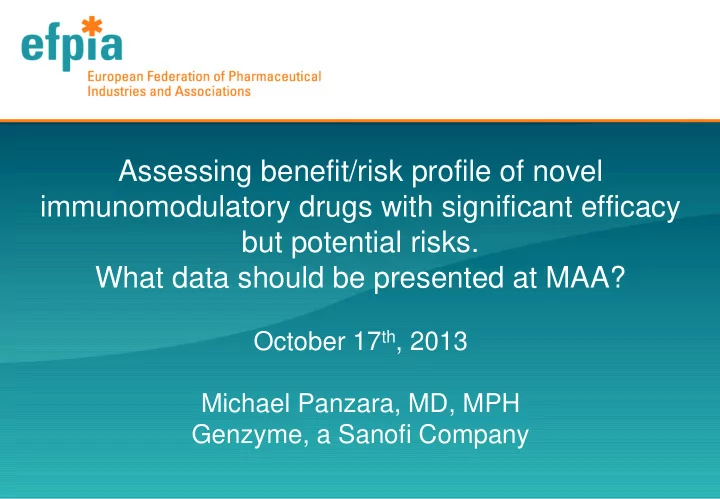

Assessing benefit/risk profile of novel immunomodulatory drugs with significant efficacy but potential risks. What data should be presented at MAA? October 17 th , 2013 Michael Panzara, MD, MPH Genzyme, a Sanofi Company
MS: Serious Disease with an Evolving Treatment Paradigm • Most patients experience disease activity and accrue disability and brain atrophy despite treatment • Long-term outcome poor even in those initially thought to be “benign” • Disease activity impacts daily lives, predicts poor prognosis and increases risk for permanent disability – True for both treatment naive and patients on treatment • Has led to an evolving treatment paradigm - products with high efficacy may be given at the earliest stage of the disease to prevent irreversible neurological damage 2
MS Pathogenesis T cell Macrophage T cell activated T cell activated Neuron Oligodendrocyte Microglial cell cell Demyelination: myelin breaks up B cell into debris 3 Bloodstream Central Nervous System (CNS)
Discussions of Benefits and Risks Prominent at Start of Treatment • Natalizumab (Tysabri) experience brought discussions of benefit risk to forefront in MS landscape – Substantial efficacy, rare but significant risk • Key questions: – How much risk is acceptable when treating MS, a non-fatal yet debilitating disease? – Should patients naïve to treatment even receive a potent immunomodulatory treatment – What data should be provided pre-MAA to assure patient safety? 4
Draft Guidance Reflects Cautious Approach Influenced by Tysabri Legacy “For compounds with an anticipated profound effect on the immune system and thus potential serious safety concerns these risks may be outweighed by a larger effect…the product should be evaluated in a comparative superiority study in patients insufficient responsive to first line treatment and/or an (anticipated) rapid progression of their disease…if the safety has raised no major concern, superiority studies versus first line treatment/placebo may be considered to evaluate efficacy in a broader multiple sclerosis population.” 5
Approach Potentially Impedes Development of Novel Therapeutics • Mandates universal approach to immunomodulatory treatments based on theoretical risks without consideration of other factors, e.g., mechanism, target, etc • Requires initial study of those later in disease where benefit-risk profile may be less favorable • Restricts potent immunomodulators from those most likely to benefit early in disease – Two-step approach that delays access to therapies of potentially great benefit, without enhancing benefit risk 6
Recommendations in Draft Guidance Will Not Enhance Benefit-Risk • Supported by Tysabri experience – No ‘profound effect on immune system’ anticipated or apparent from preclinical or clinical studies • No increase in infections, changes in immune profile – Safety concern identified could not have been anticipated • Nothing that could have been presented at MAA could have predicted PML – Restriction of Tysabri to later stages of disease has had the unintended consequence of directing the treatment to those of highest risk of PML (e.g., prior immunosuppression) 7
Lemtrada Development Illustrates More Pragmatic Approach • Parallel development both in active patients naïve to prior treatment and those with activity on treatment • Pivotal studies conducted in consideration of risks predicted based upon MOA or identified in MS pilot studies and oncology experience – All studies vs. active comparator – Disability primary endpoints in addition to relapse – Intensive risk management activities • Parallel development enabled assessment and comparison of benefit-risk across populations • Favorable benefit risk profile in active patients regardless of prior treatment reflected in labeling 8
Slowing of Sustained Accumulation of Disability (6-month SAD) Treatment Naïve 20 18 Percentage of Patients with SAD 48% reduction p=0.0052 16 13.5% 14 SC IFNB-1a 12 10 7.1% 8 Alemtuzumab 12 mg 6 4 2 0 0 3 6 9 12 15 18 21 24 Follow-Up Month Pooled data from CAMMS223 and CAMMS323 9
Slowing of Sustained Accumulation of Disability (6-month SAD) Relapsed on Prior Treatment 25 Percentage of patients with SAD 21.1% 42% reduction SC IFNB-1a p=0.0084 20 15 12.7% Alemtuzumab 12 mg 10 5 0 0 3 6 9 12 15 18 21 24 Follow-up Month Data from CAMMS324 10
Safety Profile Similar Across Patient Populations Two-Year Active-Controlled Experience Treatment-Naïve Patients 1 Relapsing on Prior Therapy 2 SC IFNB-1a Alem 12 mg SC IFNB-1a Alem, 12 mg (N=294) (N=484) (N=202) (N=435) (%) (%) (%) (%) AEs 94.6 96.7 94.6 98.4 SAEs 16.0 17.1 21.8 19.5 Identified Risks IARs 3 — 91.7 — 90.3 Thyroid disorders 5.4 17.4 5.0 15.9 ITP 4 0 0.8 0 0.9 Glomerulonephritis 0 0 0 0.2 Serious infections 0.7 1.9 1.5 3.7 1 Pooled from CAMMS223 and CAMMS323 2 Data from CAMMS324 3 Infusion Associated Reactions 4 Medically confirmed ITP 11
Data Included at MAA Should Be No Different for Novel Immunomodulators than for Other Novel Compounds • Sufficient numbers of patients to detect risks of most concern • Sufficient duration of exposure and follow-up based upon MOA and PD effects • Appropriate comparator selected based upon therapeutic landscape (e.g., placebo or active comparator) • Efficacy and safety across MS spectrum – Active patients regardless of time since diagnosis or prior treatment history – Restricting population prevents understanding of benefits and risks in patients most likely to be treated and to benefit • Robust post-marketing plan that allows detection of rare events not likely seen during clinical development 12
Recommend
More recommend